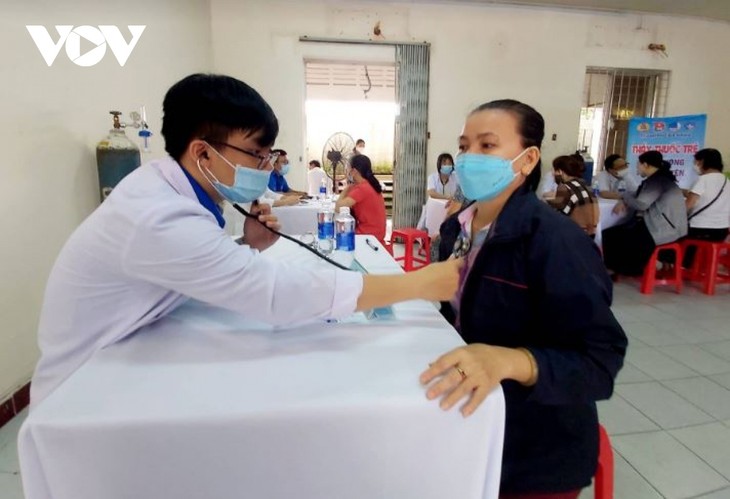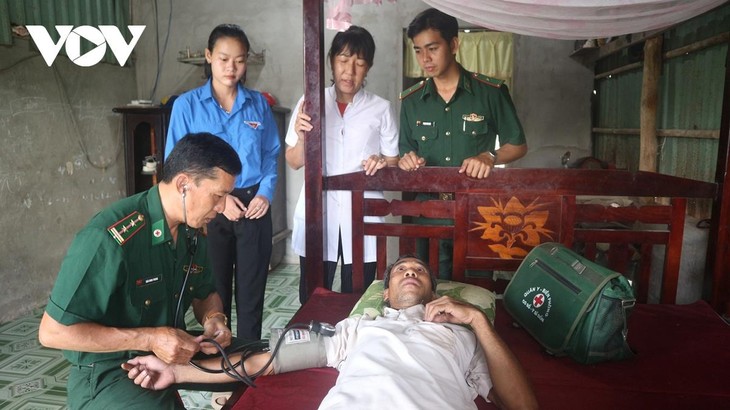(VOVWORLD) -Vietnamese Doctor’s Day, observed on February 27th, is a day to honor doctors and medical workers and acknowledge the achievements of the health sector. The top goal of the Vietnamese Party and State is to build a fair, high-quality, effective, and internationally-integrated health care system, toward universal health care and universal health coverage.
 Young volunteer doctors offer free medical checkups for workers in Da Nang. (Photo: VOV) Young volunteer doctors offer free medical checkups for workers in Da Nang. (Photo: VOV) |
The health sector has obtained major achievements to make Vietnam a bright spot in implementing the UN’s millennium goals and meeting the UN’s sustainable development goals by 2030.
Impressive figures
Vietnam has an extensive medical system covering all remote areas, borders, and islands, with 11,400 medical stations in communes, wards, and towns. The Health Departments of all 63 provinces and centrally-run cities and more than 4,000 medical facilities have deployed an electronic prescription system connected to the national prescription system. Vietnam has 12.5 doctors per 10,000 people and 32 hospital beds per 10,000 people. 93.2% of the population have health insurance.
Vietnam is a leader in reducing maternal and infant mortality rates. People's health indicators have significantly improved. The poor, ethnic minorities, children, the elderly, and people with disabilities are all supported in accessing health services. Epidemics have been controlled or eliminated, and people's health and longevity have improved.
Many Vietnamese doctors have successfully performed difficult procedures and mastered advanced medical techniques, including interventional cardiology, endoscopic surgery, microsurgery, organ transplants, and limb transplants.
WHO General Director Tedros Adhanom Ghebreyesus praised changes in Vietnam in term of the transformation of life and health over recent decades.
“Since 1945 life expectancy has increased by 15 years with massive actions in vaccine preventable diseases, including the elimination of polio. Vietnam has also made huge strives for ending HIV, malaria, and TB epidemics. You’ve expanded social health insurance significantly putting you further along the path to universal health coverage. Progress has also been made to tackling risk factors for communicable diseases such as reducing the smoking rate,” he said.
 Lieutenant Colonel Thai Minh Phong, Head of the Military-Civilian Clinic in Lai Hoa commune, Soc Trang province examines a patient at home. (Photo: VOV) Lieutenant Colonel Thai Minh Phong, Head of the Military-Civilian Clinic in Lai Hoa commune, Soc Trang province examines a patient at home. (Photo: VOV) |
Public health care continues to be a priority
Protecting, caring for, and improving people's health is a top priority in Vietnam's development policy. Last year, the Party Central Committee Secretariat issued a Directive on consolidating and improving the quality of grassroots healthcare in the new situation. Supplements to the Directive have continued to improve the quality of grassroots healthcare units and identified new priorities.
In January the Prime Minister approved the National Strategy on protecting, caring for, and improving people's health until 2030, with a vision to 2045. The strategy aims to ensure that every person enjoys adequate health care, lives in a safe community, and develops well physically and mentally.
Health Minister Dao Hong Lan says the health sector strives to improve medical care throughout the network. “Caring for and improving people's health is the sacred mission of the health sector. The goal is to build a strong health care system to cope with all possible situations, the primary tasks being to improve the quality of medical treatment, prevent epidemics, and build a resilient health system,” Lan said.
Policy orientations and the ethics, intelligence, talent, and aspirations of medical workers and doctors have brought Vietnam's health sector to compare favorably with the top health sectors in the region and the world.